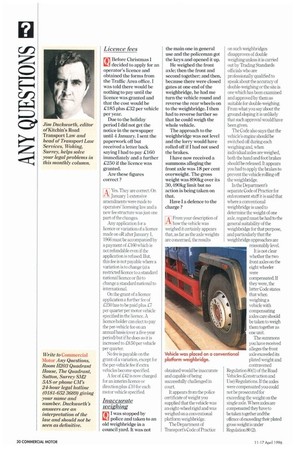Jim Duckworth, editor of Kitchin's Road Transport Law and head
Page 40

If you've noticed an error in this article please click here to report it so we can fix it.
of Transport Law Services, Woking, Surrey, helps solve your legal problems in this monthly column. Before Christmas I decided to apply for an operator's licence and obtained the forms from the Traffic Area office. I was told there would be nothing to pay until the licence was granted and that the cost would be L185 plus 432 per vehicle per year.
Due to the holiday period I did not get the notice in the newspaper until 4 January. I sent the paperwork off but received a letter back saying! had to pay £160 immediately and a further 4250 if the licence was granted.
Are these figures correct ?
IA Yes They are correct. On IJanuary 1 extensive amendments were made to Operators' licensing law and a new fee structure was just one part of the changes.
Any application for a licence or variation of a licence made on oR afterJanuary 1, 1966 must be accompanied by a payment of 1160 which is not refundable even if the application is refused. But, this fee is not payable where a variation is to change (a) a restricted licence to a standard national licence or (b) to change a standard national to international.
On the grant of a licence application a further fee of 1250 has to be paid plus ,C7 per quarter per motor vehicle specified in the licence, A licence holder can elect to pay the per-vehicle fee on an annual basis (over a five-year period) but if he does so it is increased to £8.50 per vehicle per quarter.
No fee is payable on the grant of a variation, except for the per-vehicle fee if extra vehicles become specified.
A fee of 142 is now charged for an interim licence or direction plus £10 for each motor vehicle specified.
Inaccurate weighing
I was stopped by police and taken to an old weighbridge in a council yard. It was not the main one in general use and the policeman got the keys and opened it up.
He weighed the front axle; then the front and second together and then, because there were closed gates at one end of the weighbridge, he had me turn the vehicle round and reverse the rear wheels on to the weighbridge. I then had to reverse further so that he could weigh the whole vehicle.
The approach to the weighbridge was not level and the lorry would have rolled off if I had not used the brakes.
I have now received a summons alleging the front axle was 18 per cent overweight. The gross weight was 890kg over its 30,490kg limit but no action is being taken on that.
Have I a defence to the charge ?
I A From your description of Eck. how the vehicle was weighed it certainly appears that, as far as the axle weights are concerned, the results obtained would be inaccurate and capable of being successfully challenged in court.
It appears from the police certificate of weight you supplied that the vehicle was an eight-wheel rigid and was weighed on a conventional platform weighbridge.
The Department of Transport's Code of Practice on such weighbridges disapproves of double weighing unless it is carried out by Trading Standards officials who are professionally qualified to speak about the accuracy of double-weighing or the site is one which has been examined and approved by them as suitable for double-weighing. From what you say about the ground sloping it is unlikely that such approval would have been given.
The Code also says that the vehicle's engine should be switched off during each weighing and, when individual axles are weighed, both the hand and foot brakes should be released. It appears you had to apply the brakes to prevent the vehicle rolling off the weighbridge.
In the Department's separate Code of Practice for enforcement staff it is said that where a conventional weighbridge is used to determine the weight of one axle, regard must be had to the general suitability of the weighbridge for that purpose, and particularly that the weighbridge approaches are reasonably level.
It is not clear whether the two front axles on the eight wheeler were compensated. If they were, the latter Code states that when weighing a vehicle with compensating axles care should be taken to weigh them together as one unit.
The summons you have received alleges the front axle exceeded its plated weight and contravened Regulation 80(1) of the Road Vehicles (Construction and Use) Regulations. lithe axles were compensated you could not be prosecuted for exceeding the weight on the single axle. Where axles are compensated they have to be taken together and the offence of exceeding their plated gross weight is under Regulation 80(2).




























































































































